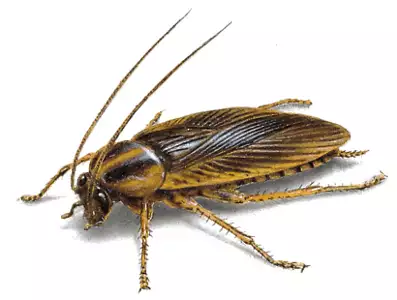- Contact
- 01211118453
- Send Email
- info@spider-eg.com
German Cockroaches

German Cockroaches Facts & Information
How to Identify & Control German Cockroaches
Latin Name
Blattella germanica
Appearance
What Do They Look Like?

- Color: Adults are easily recognized by their light brown or tan coloration with two black horizontal stripes located on the pronotum immediately behind the head, The young, or nymphs, are darker, almost black in color, also with the black stripes behind the head.
- Size: Adults grow to a length of 13-16 mm.
- Wings: While adult German cockroaches have wings, they rarely fly, preferring to run.
How Did I Get German Cockroaches?
German cockroaches are well-known indoor cockroaches with a distribution that is world-wide. Smaller than other types of cockroaches, the pests can hide in small spaces and hitch rides in bags, boxes, and many other infested items that are brought inside the home. In multi-unit apartment buildings, they can easily move between units, using the shared plumbing and pipes as a highway.
What Attracts Them?
One of the most common sources of problems with German cockroaches are used items like furniture and luggage. Pre-owned electronics are also hiding places for the pests, which gravitate towards these warm devices. Additionally, areas where food debris is left around will fulfill the needs that the cockroaches have for food, water, and protection, such as near:
- Garbage containers
- Kitchen cabinets
- Under sinks
How Serious Are German Cockroaches?
German cockroaches spread filth in homes, contaminating food and utensils. Pathogens range from bacteria that causes food poisoning and dysentery to allergens that result in rashes and asthma attacks. Recent studies have also indicated that in larger metropolitan areas, the development of asthma in children can be directly linked to the presence of the pest.
Rapid Infestation
These cockroaches lay 40 eggs at a time, which mature in about two months. Because they reproduce rapidly, infestations quickly become severe. German cockroaches are hardy and fast and have few natural predators inside human habitats. For these reasons, their populations tend to grow rapidly and can be hard to get rid of, often requiring professional treatment.
Signs of Infestation
Droppings
German cockroach droppings may appear as small, dark, “pepper-like” material left on countertops or in drawers. Fecal staining may appear as dark spots or smears:
- Along the tops of doors.
- Around small cracks and openings into walls.
- In the corners of a room.
Egg Capsules
Since German cockroach females carries their egg case until 1 to 2 days before depositing it, empty egg cases may be found in areas that the females frequent.
Odor
German cockroaches are also known to secrete a number of odorous compounds. When populations are present in large numbers, it may be possible to detect a mild, or what some have reported as a “musty” odor.

